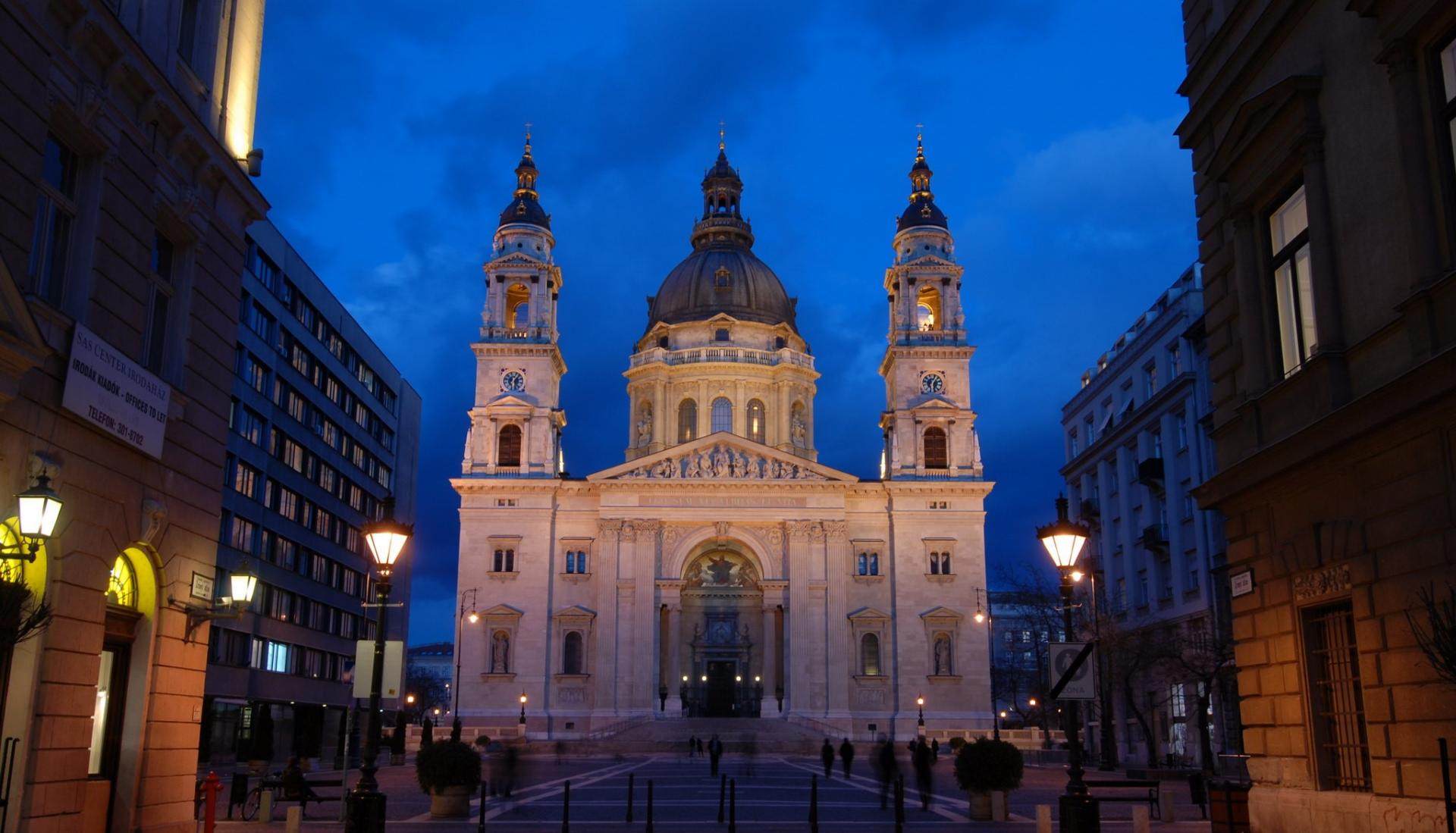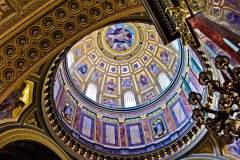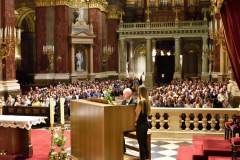Organ Concert
Mo | Tu | We | Th | Fr | Sa | Su |
Explore the enchanting side of Hungary with the magnificent Organ Concert at the largest church in Budapest, the St. Stephen’s Basilica!
The more than 100 year-old church, one of the most important icons of Budapest gives home to this grandiose series that will sure to move you if you consider yourself a fan of the classics.
Indulge in a 70 minute performance by celebrated Hungarian organ artist Miklós Teleki and his small ensemble of an award winning opera singer Kolos Kováts and a talented flute artist from the Danube Symphonic Orchestra Eleonora Krusic. As the music calmly flows through the majestic gold-plated interior of the St. Stephen’s Basilica, taking advantage of its unmatched acoustics, your shivers will tell you instantly that you are in the right place at the right time.
The basilica, named after the first king and state founder of Hungary, is the largest building of Budapest, a holy sanctuary in which a concert experience takes on a whole new, spiritual meaning. Take part in this grand and intimate performance and enjoy music from the greatest Hungarian and international composers such as Liszt, Vivaldi and Bach presented by three amazing local artists on a truly authentic Hungarian evening.
The sublime combination of sights and sounds will guarantee to take your breath away and leave you with an impact not soon forgotten. Take on a musical journey through Hungary’s history and culture to discover a lesser known face of Budapest!
Inclusions
70 minutes Organ concert in the Basilica
Concert ticket with seating corresponding to purchased category
Program
Antonio Vivaldi (1678-1741) - Johann Sebastian Bach (1685-1750): Concerto in D minor
BWV 596 (Allegro, Adagio, Allegro)
Tomaso Albinoni (1671-1751): Adagio
Alessandro Stradella (1639-1682): Pietá Signore
Wolfgang Amadeus Mozart (1756-1791): Andante in C major K 315
Franz Schubert (1797-1828): Ave Maria
Liszt Ferenc (1811-1866): Fantasy & Fugue on the Theme B-A-C-H
Georges Bizet (1838-1875): Agnus Dei
Johann Sebastian Bach: Minuet and Badinerie from suite in B minor BWV 1067
Johann Sebastian Bach: Toccata and Fugue in D minor BWV 565
Duration
70 minutes
Meeting point
St. Stephen's Basilica
1051 Budapest, Szent István square 1.
Meeting time
19:30 at the entrance of the Saint Stephen Basilica
Departure time
Thursday at 20:00 (plus exceptional holiday dates)
Program and cast
Antonio Vivaldi (1678-1741) – Johann Sebastian Bach (1685-1750): Concerto in D minor BWV 596 (Allegro, Adagio, Allegro)
Tomaso Albinoni (1671-1751): Adagio
Alessandro Stradella (1639-1682): Pietá Signore
Wolfgang Amadeus Mozart (1756-1791): Andante in C major K 315
Franz Schubert (1797-1828): Ave Maria
Liszt Ferenc (1811-1866): Fantasy & Fugue on the Theme B-A-C-H
Georges Bizet (1838-1875): Agnus Dei
Johann Sebastian Bach: Minuet and Badinerie from suite in B minor BWV 1067
Johann Sebastian Bach: Toccata and Fugue in D minor BWV 565
St Stephen Basilica Budapest
St Stephen’s Basilica, the main Cathedral of Budapest is one of the most beautiful and significant churches and touristic attractions of the country. This is partly due to its historical heritage, of being dedicated to the holy king St Stephen who was also the founder of the Hungarian state, and partly to the architectural and artistic value of the building itself. A campaign to raise funds for the construction of the church commenced in the 1810-es, however, construction works did not start until August 14, 1851, based on the drawings of József Hild, a leading citizen and architect of Pest, who also designed the cathedrals in Esztergom and Eger. József Hild supervised the works until his death as of March 6, 1867. The Council of the City of Pest appointed Miklós Ybl, an acknowledged master at the time and designer of numerous public buildings in the capital city including the Opera House, to continue to supervise the design and construction of this prominent building. After his death, the interior of the building and the fine artistic and decorative works were completed by 1905 under the supervision of József Kauser. January 22, 1868 was an important date in the history of the Basilica. It was on this day that the cupola and the cupola drum constructed according to the designs of Hild collapsed due to defects in materials and craftmanship. The pillars holding the arches of the cupola were constructed with donated stones of assorted quality and solidity. The cupola drum was built on the inner rim of the arches underpinning it, resulting in a precariously balanced structure which distributed the load unevenly on the pillars. The imbalance of the structure in turn gave rise to the collapse, after which works paused for more than a year, when the removal of the debris and the demolition of the poorly constructed parts commenced and continued until 1871. Miklós Ybl prepared new designs for continuing the construction works or revised the previous ones in terms of the structure and the appearance alike. From 1875, the Hellenistic forms and Classicist style were replaced by Neo-Renaissance elements applied by Ybl, and works continued, even after his death of 1891, according to his sketches and ideas until the long-last dedication of the church in 1905.
(Source: A Szent István Bazilika, Budapest 1989.)
Major events of the construction and renovation of the Basilica:
1845. József Hild (1789-1867) is appointed by the Council of the City of Pest to design the Basilica.
1846. Earthworks start.
1851. After the war of independence (1848-49) he is appointed to continue the works. By this time the drum of the cupola is constructed up to a height of 51.52 m.
January 22, 1868, 5.10 p.m. The drum of the cupola collapses due to defective construction. Ybl recognizes the defect and averts hazard to life, however, he cannot prevent the disaster. He designs a new neo-renaissance building on reinforced foundations.
1875. Construction works restart based on partially modified drawings after the conclusion of the demolition works.
1890. The entire structure of the building is completed.
1891. After the death of Miklós Ybl, the final and predominantly decorative works are supervised by József Kauser (1848-1919).
1905. Interior decoration is ready and thus construction works are concluded.
November 9, 1905 – The dedication of the church
December 8, 1906: The placement of the keystone in the presence of Franz Joseph I, emperor of Austria and king of Hungary.
1931. Pope Pius XI awards the church the title “basilica minor”.
1938. The building functions as the central place of the events of the 34th International Eucharistic Congress.
1944-45 – The roof structure, the towers and the external walls are damaged in World War II. The roof structure as a whole needs to be replaced.
1947. The wooden structure of the cupola catches fire during the repair works on the roof.
1971. The Holy Right Hand of St Stephen is placed in the Basilica to be guarded there.
1982. The plate cover of the large cupola is swept on to the street below by a storm, and the church building becomes hazardous to life.
1983. Commencement date of planned reconstruction works.
1991. Pope John Paul II visits the church at the festival of king St Stephan.
1993. The pope raises the basilica to the rank of co-cathedral of the Archbishopric.
August 16, 2001 – The government transfers the title to the basilica to the Church in connection with the conclusion of the millennium.
August 14, 2003 – Conclusion of construction and restoration works.
Special construction, restoration and engineering solutions
The most spectacular idea realized during the construction works was the hanging scaffolding. For the repair of the large towers above the main ledge, the scaffold was hung from above, from the ledge on the clocktower. When renovating the inner cupola and the cupola drum, we hung a bridge structure from the windows of the cupola, which the scaffold was mounted on, up to the pitch of the cupola, and hung down to the barrel vaults. Thus we could reduce significantly the overall weight as well as the costs, by 50%.
The restoration of the mosaics in the sanctuary
As for the interior decoration of and the works of art in the church, the mosaics and the artificial marble panels on the walls suffered the largest damage. The most valuable work of art is the five-part mosaic in the sanctuary displaying the allegories of the holy mass. The mosaic was prepared by the Salviati and Jesurum companies of Venice, based on an oil painting by Gyula Benczúr. During World War II the mosaic disengaged from the soaked vault. It was forced back to its original place by the heating of the walls and the concurrent mechanical drying of the external space and injection of binding agent from the outside.
In the cupola of the Basilica, a panorama lookout was established for touristic purposes, which made it necessary to install elevators. The elevators work with frequency control, with no engine-house, saving 60% on the operating cost. The 2 chimneys behind the main façade were converted into elevator shafts and 2 elevators were installed in the cupola drum behind the statutes of the evangelists. Visitors can now access the look-out by using the two elevators and some walking, instead of having to climb 364 stairs.

 EN
EN DE
DE IT
IT FR
FR ES
ES RU
RU JP
JP RO
RO
 Seating plan
Seating plan 


